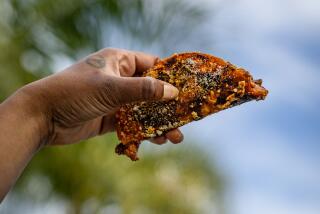Embraceable Crus : Beaujolais That’s Affordable Is Now Available on a Year-Round Basis
- Share via
EVERY NOVEMBER, the arrival of Beaujolais Nouveau, trumpeted with much fanfare and brouhaha, marks one of the high points of the fall wine calendar. And just as high are some of the prices that Beaujolais has come to command. One really needn’t wait until November, however, to enjoy the good taste of Beaujolais. Affordable ruby-red wines with year-round drinkability do indeed exist. They’re most often referred to as “Cru Beaujolais.”
Beaujolais has 10 crus , each denoting a “growth” or a region where the wine is produced: Brouilly, Chenas, Chiroubles, Cote de Brouilly, Fleurie, Julienas, Morgon, Moulin-a-Vent, Saint Amour and Regnie, which was officially added with the ’88 vintage. Equally fine Beaujolais comes from 35 other small townships or communities called Beaujolais Villages.
Each cru has its own distinct flavors. The Beaujolais Villages crus exude tastes and scents suggesting peaches, raspberries or apricots; a hint of rose petals can be detected in Brouilly, hardness and longevity in Morgon, and a quintessential loveliness in Fleurie or in the very popular Moulin-a-Vent.
Now is not a time to ask which vintages are best. Beaujolais has had four successive vintages of above-average quality, beginning with the splendid (and expensive) 1985 and leading to the reliably fine vintages of 1986 and 1987.
The word on the just-released 1988 vintage, based on samples tasted, is good. The harvest was early, after a very mild winter, with good flowering last June. Intermittent rains came at the end of September, but better growers do not bottle rain-diluted cuvees. The Hospices de Beaune auction in France, always a fair sign of how the trade reacts to a pending vintage, fetched notably high price increases last fall.
The essence of this good wine of Beaujolais is, of course, the Gamay grape. Its history has been rather tumultuous since it was brought to France from Greece by the Roman army of Probus in about AD 280. As its cultivation expanded northward into Burgundy, the monks in Cluny noticed the grapes’ abundance and their bigger clusters and sizes. Thus the Gamay’s production was still further expanded.
In 1395, Philip the Bold, ruler of Burgundy, came to believe that this grape somehow was damaging the reputation of the more low-yielding Pinot Noir of the Cote d’Or. He issued the first viticultural ruling in history and banished the Gamay grape from this heartland of the regal Burgundies, saying it was a bad and very disloyal grape. The region of Beaujolais, south of Macon, became the new home for this “bad” grape, and the rest, as they say, is history. In almost every village, the Gamay Noir au jus Blanc, “the black Gamay with white juice,” with its ripe raspberry tastes, has produced one of the most delectable wines the world has ever known.
A variety of wine makers offer good, affordable Beaujolais. From the village of Saint-Lager, the Pasquier-Desvignes family has been producing Beaujolais since 1420. The Chateau de la Chaize, near Brouilly, has been around since the 17th Century and is a favorite of wine lovers. Its 1987 vintage costs about $10 and is in constant demand.
The House of Thorin traces its roots back to the 5th Century and the abbeys of Cluny and St. Pierre at Romaneche-Thorin. Near this ancient hamlet is the Chateau des Jacques, a Moulin-a-Vent vineyard owned for many years by the 19th-Century commercial wine house of Benoit Thorin. The 1985 Chateau des Jacques Moulin-a-Vent is a treasure worth seeking ($15).
And Andre Gagey, of Louis Jadot, with his son Pierre-Henri, is always proud of his cru Beaujolais. The 1987 Louis Jadot Beaujolais-Villages ($7.50) is a constant best-seller.
Last June, I was in France, near Macon, having lunch with wine maker Didier Mommessin at the rustic L’Auberge de la Grange du Bois, just above the villages of Pouilly and Fuisse. The easy, light Mommessin 1987 Brouilly, Chateau de Briante, accompanied our meal. I asked my host whether the ’88 vintage, which was coming into full flower at the time, would be just as good. Mommessin allowed me to judge the affordable cru Beaujolais for myself recently by personally bringing me barrel samples from France. The results:
BEAUJOLAIS-VILLAGES 1988 Chateau de Montmelas ($7). From this 16th-Century castle-vineyard estate comes glorious and brilliant wine of jewel-ruby color. The whole-bodied Gamay Noir wine has intense fruitiness, yet no sweetness.
BROUILLY 1988 Chateau de Briante ($9.75). Another jewel of charming character, suggesting more nobility in Burgundian style than light Beaujolais. It’s a principal wine that is still unpretentious in its easy drinkability.
FLEURIE 1988 Clos de la Roilette ($13.50). In translation, the name of this, one of the largest vineyards of Beaujolais, means “flowery.” Brief aging in used oak barrels, after 10 to 12 days of maceration, gives the wine a subtle, softer taste.
MOULIN-A-VENT 1988 Domaine de Champs de Cour ($8). Named for an old windmill landmark in the district, this is nominally one of the most prestigious cru of Beaujolais. It’s akin to the regal wines of the Cote d’Or in full-bodied elegance. There’s a deep raspberry aftertaste for this smooth, well-balanced wine that five years of cellar aging would grace. A rare bargain.
More to Read
Eat your way across L.A.
Get our weekly Tasting Notes newsletter for reviews, news and more.
You may occasionally receive promotional content from the Los Angeles Times.








